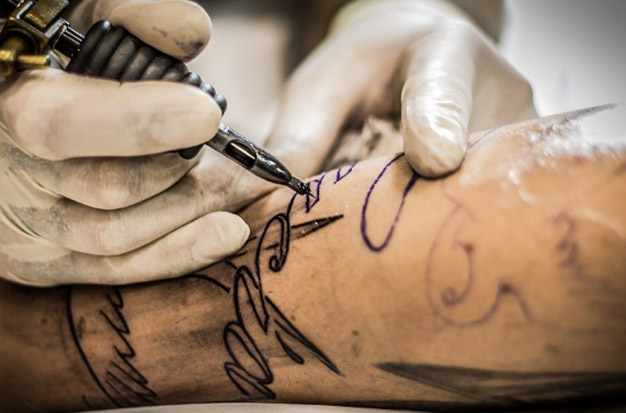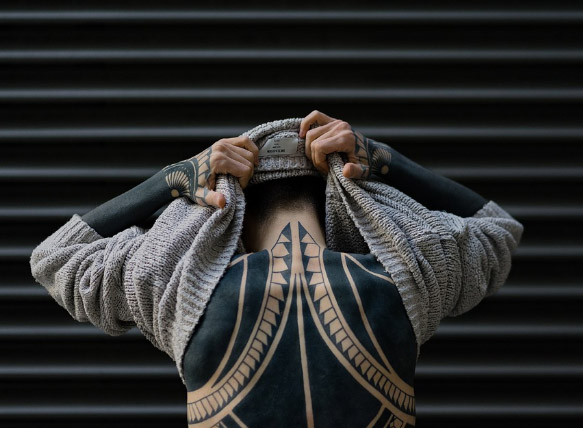
How Deep Does a Tattoo Needle Go Into The Skin?
What about getting a tattoo scares you the most? The needle is what most people think of. You fear that the discomfort might be excessive or that the needle might stick too deeply. What happens to your skin when tattoo ink is injected into it? The majority of it stays firmly implanted there, but some pigments move to lymph nodes or even locations further away in your body. You are still left with a new tattoo throughout.
How Does a Tattoo Machine Work?
There are numerous tattooing techniques. Some of them have been in use for countless years. However, in the majority of modern tattoo parlors, such as Oracle Tattoo Gallery, the tattoo artists employ electrically powered machines as their primary tool of the trade.
A tattoo needle attachment on the tattoo machine inserts the needle 6,000 times per minute into the skin. However, the ink isn’t injected into the skin with the needle. Instead, the skin is punctured while the machine allows ink to collect on the skin’s surface. The skin puncture creates a vacuum as the needle retracts, drawing the ink in far enough to set it permanently.
All About The Tattoo Needle
We must start with the fundamentals—the tattoo machine, of course—in order to comprehend the whole situation with the tattoo needle. Around the globe, people get tattoos using the conventional tattoo machine, an electrical machine.
Using a particular mechanism of electromagnetic coils that move the armature bar up and down at a rate of 6,000 motions per minute, the standard tattoo machine pulses a tattoo needle into the skin.
The absence of ink, however, renders a tattoo machine useless. The ink must be transferred into the skin while the needle is being pushed into and out of the skin. Do you recall the armature bar? The ink is pushed into the skin by a barred needle grouping that is attached to this bar.
Typically, tattoos are made of steel, nickel, or chrome. Though some needles can be significantly thinner, the typical thickness ranges from 0.30mm to 0.35mm. Magnum or bug pin needles measure 0.20–0.25 millimeters.
Additionally, there are various needle shapes for dotting, shading, and coloring. For example, lines and shading are best achieved with round needles, while dark lines with crisper edges are best achieved with flat needles.
No matter their size, shape, or intended use, all tattoo needles are sterilized before use and discarded after your tattoo is complete.

How Deep Does The Needle Actually Go?
The third and final piece of the puzzle—your skin—can now be discussed since you are more familiar with the machine and the needle.
The dermis layer of the skin should be penetrated by the tattoo needle. This layer, which is located in the middle, is ideal for ensuring that the ink will stay in the skin and not “bleed out” as the tattoo heals.
The hypodermis is too deep into the skin, which means the ink won’t be as visible and the pain during tattooing will be twice as intense. The epidermis is not a good ink location because it is too exposed and too outward. The client will undoubtedly become infected if the needle penetrates the hypodermis.
The skin is punctured by the tattoo needle 1/16th of an inch deep. Despite the fact that it only seems like a small amount of skin, that actually includes the top layer of the dermis as well as five sublayers of the epidermis. Sweat glands, hair follicles, connective tissue, fat, and blood vessels are all distributed throughout these layers.
The 2mm-thick dermis is accessed during a tattoo session by the needle puncturing the epidermis and epidermal-dermal junction. The dermis is ideal for a number of reasons. It is covered and spaced apart enough to prevent bleeding.
Knowing this, the tattoo needle’s tip is carefully modified to ensure that it penetrates the skin at the proper depth. A tattoo needle in the machine sticks out no more than 2mm, as you can see if you look at it.
Pain Level
Different people have different thresholds for pain. However, because the cheek is cartilage-free, piercing it may be less painful than piercing a site with a lot of cartilage, like the upper ear or the nose.
Some people may taste blood after the piercing, and the area may swell up. This is typically only temporary because the bleeding will stop as the wound mends.
Costs
The location and caliber of the jewelry determine how much a cheek piercing will cost. Typically, it will fall between $40 and $100.
It may cost more or less depending on whether one or both cheeks are pierced.
People should always confirm that the piercer is qualified and experienced to perform the procedure.
The Ability To Inject Ink Into Blood Vessels By The Needle
One of the most frequently asked questions about tattoo needles relates to the potential for the needle to enter and inject the ink into veins.
As previously mentioned, the dermis layer of the skin contains veins or blood vessels. Therefore, there is a possibility that the tattoo needle will pierce a vein. However, a knowledgeable tattoo artist is aware of how to control the needle and make sure that only a tiny amount of ink penetrates the skin. So, even if the ink gets into the blood vessels, there won’t be any problems.
Truth be told, once you get a tattoo, the ink will be in your body and bloodstream regardless of the blood vessels. However, the body’s robust immune system can disintegrate the ink.
Because proficient tattoo artists are aware of how deeply their needles must penetrate the skin, ink in the bloodstream does not pose a threat. The amount of ink that enters the bloodstream if they don’t pay attention to this crucial detail may lead to toxicity problems.
Because of this, it’s crucial to only have your tattoo done by qualified experts at reputable tattoo studios and salons.
What If The Needle Is Too Deep Or Shallow?
Now that you are aware that a tattoo needle penetrates the skin for approximately 1/16th of an inch, you may be curious as to what would happen if the needle was inserted either too shallowly or too deeply.
The epidermis is not an ideal surface for ink. It regenerates itself every three weeks and is also exposed to the elements. This indicates that any ink that gets stuck in the epidermal layers fades and disintegrates.
Additionally, any bleeding that takes place will force some ink out when the needle leaves the skin and ink is sucked in. All the color will be removed from a tattoo before it has a chance to heal if the ink is applied too shallowly under the skin. The ideal situation is a tattoo that has started to fade and will soon disappear.
The hypodermis lies beneath the dermis. The likelihood of complications increases if the needle penetrates that deeply. In addition to being more challenging for the ink to remove from the skin, you won’t be able to clearly see it. Additionally, you should prepare yourself for a very painful tattooing procedure. Even infections or tattoo blowouts, in which the ink moves around the fat layer and distorts the shapes, may result from ink that is trapped in the hypodermis.
In either case, you don’t want that to happen.
Does The Ink Transfer To Blood Vessels?
This is a typical query. What occurs if inadvertent ink injection into a blood vessel occurs with the needle?
The dermis contains blood vessels, so it’s possible. Having said that, a skilled tattoo artist from any of the top tattoo parlors in Philadelphia will be aware of how to guide needles. Even if a vein is cut, problems resulting from that are unlikely. Your tattoo artist also guards against ink toxicity. This is why they practice keeping the needle at a constant 1/16th of an inch and no further.
However, the ink will always be absorbed through your lymph nodes and bloodstream. These pigments are absorbed by specific dermal cells, which distribute them throughout your body. The human body has a remarkable immune system that can handle ink, which is a blessing.
Aftercare
To properly care for a cheek piercing, a person can perform the following steps:
- Liquid antibacterial soap should be used to clean the piercing’s exterior. If the soap is too strong, dilute it one to one with water. Apply it with a cotton bud to the piercing.
- Once the area has been cleaned, turn the jewelry slowly.
- For a minimum of 8 weeks, do this at least twice daily.
The National Health Service (NHS) of the UK advises using a homemade saline solution to clean a fresh piercing. To do this, mix one-quarter teaspoon of salt with 40 milliliters, or about a glass, of water. People should only use a brand-new paper towel to dry the piercing.
If a person is unsure of how to properly care for the piercing, they should speak with a doctor or piercer.
Conclusion
To simulate dimples or accentuate already present ones, some people choose cheek piercings. When done correctly and by a skilled piercer, cheek piercings are risk-free, but because they are so close to the parotid gland, they are more dangerous. Nevertheless, there is always a chance of infection as with other piercings.
Visit Oracle Tattoo Gallery in Philadelphia if you’re considering getting your very first tattoo or want to enhance your existing body art. Our tattoo artists strive to create the tattoo that you have imagined. To schedule a consultation right away, give us a call or send us an email.





Average Rating